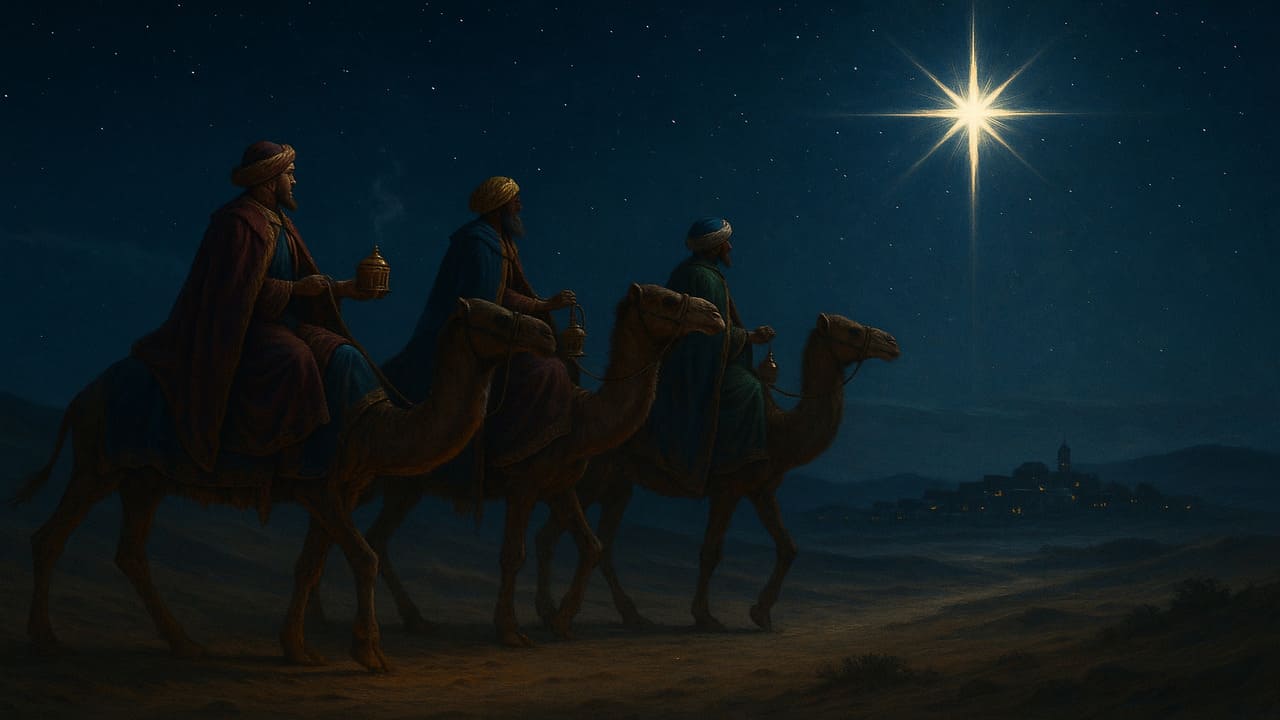
Thorn Ville Church – The Three Wise Men, often called the Magi, step onto the stage of history as learned travelers from the East who came to honor a newborn king with gifts of gold, frankincense, and myrrh. Tradition later gave them the names Caspar, Melchior, and Balthazar and imagined them as representatives of different regions, tying the story to a wider world beyond the borders of Judea. Whether they were astrologers, court scholars, or diplomats, they appear as figures who read the world carefully and respond with reverence rather than fear.
Their presence bridges cultures. They do not belong to the shepherds’ fields or the local town. Instead, they appear as outsiders willing to cross deserts because they believed that truth, once glimpsed, deserves pursuit. That mix of intellect and humility is part of why their story has lasted. The Wise Men are less about titles and more about posture: people who hold knowledge in one hand and wonder in the other.
What sends them west is a sign in the sky, a star bright enough to capture attention yet mysterious enough to demand interpretation. In the ancient world, stars were read like texts. To the Magi, the heavens were not merely decorative; they were meaningful. The star becomes a compass for the heart as much as the map for their feet. They do not know every turn of the road. They only know the next step, and they take it.
The journey is long, and that length matters. The story is not about teleportation to a revelation; it is about time, questions, and patience. They ask around, make mistakes, take detours, and ultimately arrive. The star does not erase uncertainty; it accompanies them through it. Modern readers can recognize this rhythm. Most meaningful journeys still work this way: a spark of conviction, a season of travel, a moment of recognition.
Read More : The Ten Plagues: A Story of Faith, Power, and Divine Justice
The gifts are famous because they speak without words. Gold carries the weight of royalty, the tangible acknowledgment of kingship. Frankincense, a resin burned in sacred spaces, gestures toward worship and the presence of the divine. Myrrh, used in perfumes and burial rituals, introduces a sober note that hints at suffering and sacrifice. Taken together, the gifts read like a compact poem: honor, reverence, and the cost of love.
Beyond symbolism, the gifts remind us that generosity is not an afterthought; it is part of the act of recognition. The Magi do not arrive to collect, they arrive to give. Their giving also costs them something. Precious resins and metals were hard-won items that crossed trade routes and empires. They had to decide that a child in an unremarkable setting was worth their finest treasures. That reversal splendor kneeling in a humble house anchors the moral center of the story.
As centuries passed, communities retold the story in their own colors and textures. In parts of Europe, Epiphany traditions celebrate the arrival of the Wise Men with parades, sweet bread hidden with small surprises, and chalk markings over doorways as a blessing for the new year. In Latin America and Spain, children leave shoes out for gifts from the Three Kings, turning the Magi into beloved bearers of joy. The Middle East and North Africa, echoes of the tale surface in art and liturgy, where the travelers often appear dressed like local scholars or merchants.
These cultural footprints are not mere decoration. They show how a story becomes a mirror, reflecting the hopes of people who cherish it. The Wise Men’s trek is reimagined in deserts and mountain villages, in medieval manuscripts and modern street festivals. Each retelling says the same thing in a different accent: wisdom moves, seeks, and kneels.
Also Read : Zeus Was No Hero: The Shocking Truth Behind the King of the Gods
Scholars have debated how to locate the Magi historically, proposing connections to Persian astrologers, Babylonian schools, or Arabian caravans. Astronomers have suggested comets, planetary conjunctions, or novas as the star. Artists have set the scene in countless styles, and poets have followed in their footsteps, from ancient hymns to modern verse. None of this is accidental. The Three Wise Man story invites investigation because it lives at the meeting point of history and meaning.
But perhaps the most important question is not whether we can verify every detail; it is what the story trains us to notice. The Wise Men notice a light and ask what it means. They refuse to let distance or ambiguity cancel their search. They hold their status loosely enough to kneel. In an age saturated with information yet often starved for wisdom, the Magi feel contemporary. Their method is slow, relational, and attentive to signs that others might ignore.
Thornville Church - Your Source for Biblical Inspiration - The miracle of spiritual deliverance appeared in Philippi when Paul freed…
Thornville Church - Your Source for Biblical Inspiration - Historians now highlight how women in early church shaped theology, leadership,…
Thornville Church - Your Source for Biblical Inspiration highlights how church orientation toward east shapes Christian worship, architectural symbolism, and…
Thornville Church - Your Source for Biblical Inspiration reports that recent necropolis discoveries at Colossae are reshaping how scholars read…
Thornville Church - Your Source for Biblical Inspiration highlights how oldest church sites 2025 continue to stand as living testaments…
Thornville Church - Your Source for Biblical Inspiration highlights how ancient churches and sites continue to attract pilgrims, travelers, and…